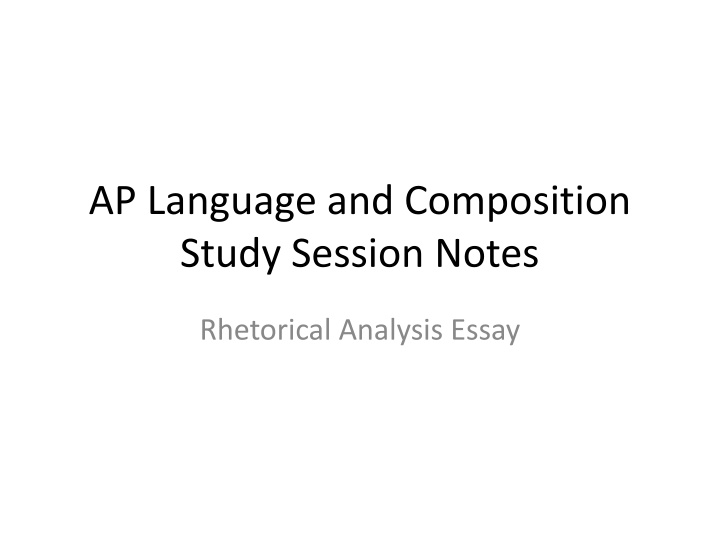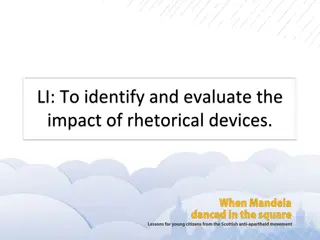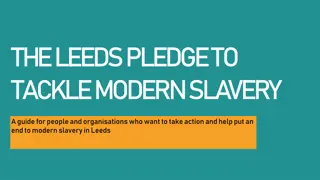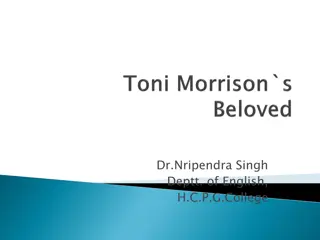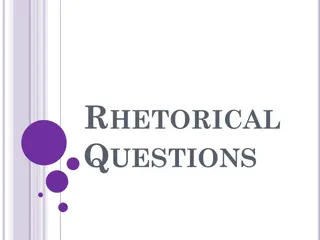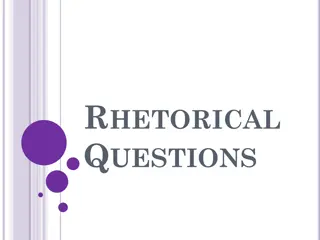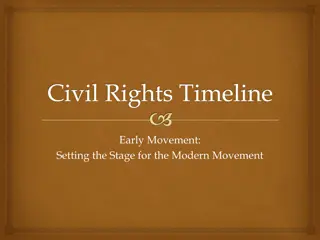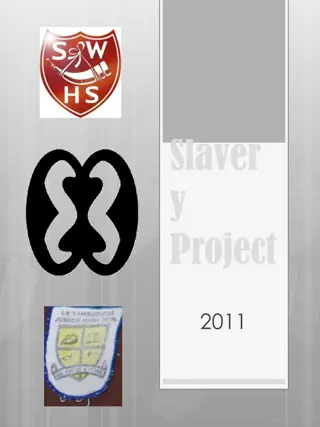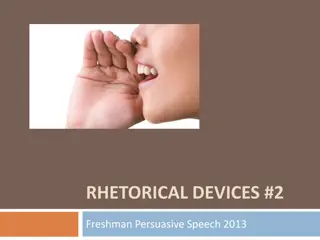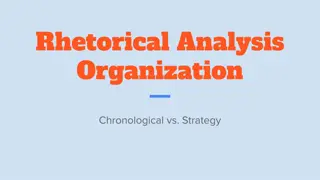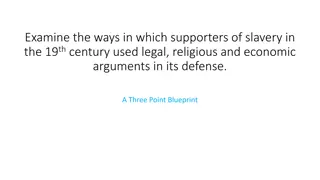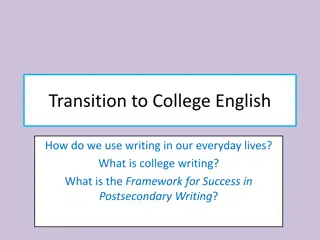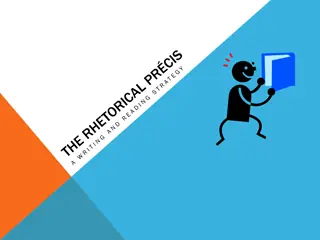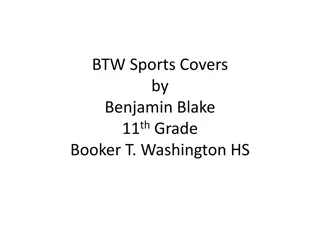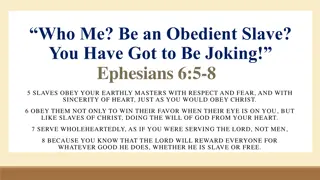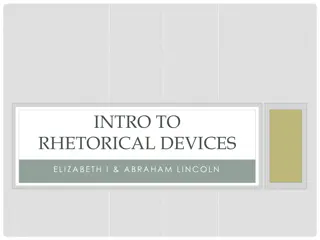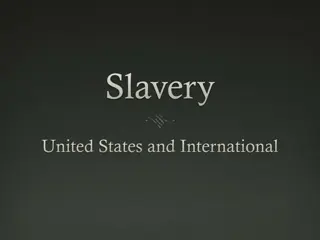Analyzing Benjamin Banneker's Rhetorical Strategies Against Slavery
Explore how Benjamin Banneker, a former slave's son, utilized rhetorical strategies in his letter to Thomas Jefferson to argue against slavery in 1791. Understand Banneker's background, intended audience, and historical context to grasp the effectiveness of his argument.
Download Presentation

Please find below an Image/Link to download the presentation.
The content on the website is provided AS IS for your information and personal use only. It may not be sold, licensed, or shared on other websites without obtaining consent from the author.If you encounter any issues during the download, it is possible that the publisher has removed the file from their server.
You are allowed to download the files provided on this website for personal or commercial use, subject to the condition that they are used lawfully. All files are the property of their respective owners.
The content on the website is provided AS IS for your information and personal use only. It may not be sold, licensed, or shared on other websites without obtaining consent from the author.
E N D
Presentation Transcript
AP Language and Composition Study Session Notes Rhetorical Analysis Essay
Presenter Notes In order to write an effective essay, students must clearly understand the task given in the prompt. Often the College Board will include information that will help students determine the author s purpose and the intended audience. Students should be encouraged to include prior knowledge from AP US History, documentaries, and personal reading.
Step One: Understanding the Prompt Read the prompt and answer questions #1-4 Benjamin Banneker, the son of former slaves, was a farmer, astronomer, mathematician, surveyor, and author. In 1791 he wrote to Thomas Jefferson, framer of the Declaration of Independence and secretary of state to President George Washington. Read the following excerpt from the letter and write an essay that analyzes how Banneker uses rhetorical strategies to argue against slavery.
Step One: Understanding the Prompt 1. Who was Benjamin Banneker? From the information given in the prompt, what inferences can we make about him? What prior knowledge do you have of Banneker? The son of former slaves should indicate to students that Banneker was not a slave. His accomplishments in astronomy, mathematics, and surveying indicate that he was an intelligent and accomplished African American. Students should be encouraged to share any additional knowledge of Banneker, who owned a tobacco farm.
Step One: Understanding the Prompt 2. Who was his intended audience? What inferences can we make about the connection between Banneker and his audience? The letter is to Thomas Jefferson, Secretary of State. Students should realize that this was after Jefferson had penned the Declaration of Independence, but before he became the third President of the United States (1801- 1809). Banneker is therefore very respectful of Jefferson s position and authority in the first two paragraphs, yet bold enough to point out that Jefferson should be found guilty of that criminal act for his participation in slavery. While Jefferson supported the end of slave trade, he was a slave owner himself and very aware of the economic influence that abolition would have on plantation owners.
Step One: Understanding the Prompt 3. What is the historical significance of the year in which the letter was written? In 1791, the United States had only been free from British rule for a short time. The Declaration of Independence was signed on July 4, 1776, but the Treaty of Paris ending the American Revolution was signed in 1783. African Americans, both free and slaves, had fought on the side of the Americans and British during this war.
Step One: Understanding the Prompt 4. In your own words, complete this statement I am going to write an essay that: explains how Banneker uses rhetorical devices to show Thomas Jefferson that he should help end slavery.
Step Two: Reading and Annotating the Passage Read the passage to determine if there is a pattern to the author s word choice. Is the diction particularly positive or negative? Which words have certain connotations for the intended audience? Are any words repeated throughout the passage? What is the overall effect of the author s word choice? Would the author have chosen different words for a different audience?
Step Two: Reading and Annotating the Passage Diction or Detail? Many times readers confuse the terms diction and detail. The distinction is in the number of words. Diction refers to one specific emotionally charged word that has meaning beyond the text. A detail is a phrase of two or more words that provide description or facts for the reader. Details can also contain connotative diction for an emotional appeal.
Step Two: Reading and Annotating the Passage Diction Associated with Slavery Negative (-) Positive(+) Paragraph 1 Tyranny , unavailable servitude, exposed dangers, reduce conflict, inability grateful, freedom miraculous, tranquility providential, mercifully preservation, blessing Paragraph 2 injustice, apprehensions true, valuable, horrors abhorrence (disgust) life, liberty worthy, happiness, endowed
Step Two: Reading and Annotating the Passage Details Associated with Slavery Negative (-) Positive(+) Paragraph 3 detested in others criminal act found guilty fraud and violence under groaning captivity cruel oppression tender feelings proper ideas valuation of liberty equal and impartial distribution
Determining Tone Analyze Banneker s pattern of diction and details to determine the author s tone, and then complete the sentence below. The negative diction and details clearly show that Banneker is that Banneker is _________, _________, and _______concerning the issue of slavery, while the positive diction and details show ______________________, ____________________, and _________________________ concerning the need to end slavery. his sublime and spiritual views indignant disdainful furious his compassionate feelings his ecstatic hopefulness
Meaning, Purpose, Effect? Before you write an effective essay, you must first clearly understand the meaning (content) of the text and the purpose of the text concerning the writer s intended audience. Your assignment is not to write a paper that identifies rhetorical devices, but to write a paper that explains why the writer uses certain rhetorical devices and how these devices affect the meaning of the text.
Meaning, Purpose, Effect? Paragraph One The words you cannot but (lines 9 and 11) show that Banneker believes that Jefferson has only one logical conclusion after he recalls, looks back, and reflects. 1. Banneker s conclusion is that: Jefferson must be grateful that he is no longer under the tyranny of the British. Jefferson must acknowledge his freedom is a blessing from heaven.
Meaning, Purpose, Effect? Paragraph One 2. What does Banneker accomplish with respect to his audience in paragraph one? Banneker implies to Jefferson that there is a similar situation between how the American colonists were treated under the tyranny of the British and how African Americans are being treated by white American colonists. He also implies with phrases like providential preservation and mercifully received that the liberty Jefferson enjoys is a gift from God.
Meaning, Purpose, Effect? Paragraph Two 1. What words does Banneker quote in paragraph two? Words from the Declaration of Independence 2. When were these words written? 1776 3. Why is this significant? Jefferson wrote these words 15 years before, yet he has not indicated by his actions or his political influence that he truly believes all men are created equal. 4. What does Banneker accomplish with respect to his audience in paragraph two? Banneker again reminds Jefferson of the horrors and injustice of British tyranny. He then flatters Jefferson for writing the true and valuable beliefs in the Declaration of Independence. The phrase that you publickly held forth sets the stage for Banneker s upcoming rebuke in paragraph three.
Meaning, Purpose, Effect? Paragraph Two Use the fill-in-the-blank activity to summarize paragraph two. Mr. Jefferson, you obviously understood the _______ of slavery. You found slavery so _________ that you declared _______ your belief that All _____ are created _____ and should have the right to ___, ______, and the ______ of happiness. injustice detestable publicly equal men life liberty pursuit
Meaning, Purpose, Effect? Paragraph Three To help you with a close reading of paragraph three, answer the following questions. 1. What would an appropriate synonym be for tender as used in line 26? compassionate 2. Yourselves in line 27 is a plural reflexive pronoun. To whom could it refer? Jefferson and the other political leaders of the time, the American colonists, the writers of the Declaration, Jefferson and other white Americans. 3. What is the subject for the verb had engaged in line 27? Time
Meaning, Purpose, Effect? Paragraph Three To help you with a close reading of paragraph three, answer the following questions. 4. Thusmeans in the way just indicated. What does the phrase thus to declare (line27) refer to? This statement relates to the previous paragraph where Banneker quoted Jefferson s words from the Declaration so independence. Banneker reminds Jefferson again of his own words and tells Jefferson that then he had the proper ideas. 5. You can be either a singular or plural pronoun. If the pronoun is singular in line 30, to whom could it refer? If it is plural, to whom could it refer? Jefferson (singular) / All white Americans (plural) 6. What did Banneker mean by entitled by nature (line 31)? Because Jefferson was born white, he had privileges.
Meaning, Purpose, Effect? Paragraph Three To help you with a close reading of paragraph three, answer the following questions. 7. Re-write this sentence in normal word order: sir, how pitiable is it to reflect It is how pitiable to reflect 8. Line 31-41 contain three dependent clauses introduced by the word that. List them. You were convinced, you should counteract, you should be found guilty. 9. In lines 32-35, of what was Jefferson convinced? That in his kindness God had given all men the same rights and privileges.
Meaning, Purpose, Effect? Paragraph Three To help you with a close reading of paragraph three, answer the following questions. 10. According to Banneker, how did Jefferson counteract God s mercies (line 36)? If Jefferson truly believed that all men were created equal, then he would use his political influence to abolish slavery 11. According to Banneker, what criminal act has Jefferson committed (line 40)? Jefferson watched as Banneker s brethren were kept in slavery. He could also be referring to the fact that Jefferson himself owned slaves. 12. What does Banneker accomplish with respect to his audience in paragraph three? In the beginning of paragraph three, Banneker is still very flattering to Jefferson and compliments his proper ideas about the value of freedom. However, Banneker s tone shifts. In essence, he tells Jefferson he should be ashamed of himself for believing one way and behaving another.
Rhetorical Devices and Strategies Often the words rhetorical devices and rhetorical strategies are used interchangeably. However, usually devices refer to the literary terms associated with rhetoric like anaphora, hyperbole, metaphor, etc. Rhetorical strategies are the persuasive techniques that a writer uses to craft his argument like ethical, logical, or emotional appeals.
Rhetorical Devices and Strategies Rhetorical Device Rhetorical Strategy Explanation of Effect Repetition of sir To create an _______ appeal The repetition of Sir showsBanneker s respect for Jefferson s position and his political influence. This politeness is necessary to offset the harshness of his words in paragraph 3. Think ETHOS Repetition of time To create an _______ appeal The repetition of time reminds Jefferson of a period in recent history when although he was a free man, he felt himself under bondage to British rule. It is a logical argument to remind Jefferson of a personal experience similar to Banneker s cause. Think LOGOS The use of Biblical diction establishes a common belief that Banneker and Jefferson share. His reference to theFather of mankind implies both are children of the same heavenly father and as such should have the same entitlements. By showing that he believes in the blessing of heaven, he furthers an emotional appeal to Jefferson s Christian charity. Biblical diction To create an _______ appeal Think PATHOS
